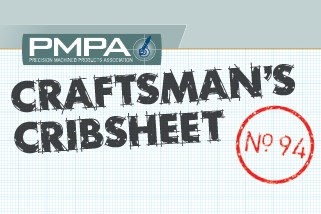Recovery, Recrystallization and Grain Growth — Three Phases of Annealing
Below are some of the terms and effects applicable to annealing steel.
#pmpa

In our shops, we typically process metallic materials that have been cold worked. This cold working provides advantages over the initial hot-rolled material: improved mechanical properties (increased yield to tensile strength ratio), reduced ductility (crisper chip), and improved dimensional characteristics, including reduced out-of-roundness and improved straightness. Cold worked materials are capable of changes in mechanical properties and microstructure when heated to and held at increased temperatures.
Commercially, we often decide to apply heat to modify or reduce the properties resulting from cold work. This improves the results of our process, but these improvements must be worth the expense of the thermal treatment. The following explains some of the terms and effects applicable to annealing steel.
Featured Content
Cold work is a process of deforming a metal below its recrystallization temperature. The cold work strengthens the material by increasing dislocations in the crystal matrix. The drawing of cleaned, hot-rolled steel through a carbide die at ambient temperatures is called cold drawing, and is widely used to increase strength, reduce ductility, and improve size, shape and straightness.
Recovery occurs at low temperatures and reduces or eliminates work hardening effects. Interestingly, the grain structure is not affected, leaving existing grain boundaries (size) intact. As a result of recovery at low temperatures, small changes in hardness occur due to decrease in density of microstructural characteristics created by the initial cold work.
Recrystallization occurs when sufficient thermal energy is available to drive the creation and strain-free growth of new grains in the existing matrix. It is a diffusion process, driven by the increased thermal energy. The growth of these new grains eliminates the distortions in the existing matrix, effectively erasing the increase in mechanical properties that had resulted from the cold work. This returns ductility to the material as well as reducing tensile and yield strength. For our shops, this means lower hardness and gummier, less brittle chips. In very high carbon grades, the diffusion into a spheroidal form of carbides results in an improvement in machinability and surface finish by increasing the mean free path of ferrite between the carbide spheroids.
Grain growth is the result of continued high temperatures past recrystallization as the grain boundaries are eliminated, resulting in an increase in the present grain size regardless of its prior austenitic grain size. Large oversize grains observed in a nominally fine-grained steel are evidence of time and temperature at or above the recrystallization temperature.
Stress relieving is a low-temperature recovery process for cold-worked steel. Sometimes these stress reliefs are called sub-critical anneal. The material never changes phase.
Annealing is a process of heating and holding the material at sufficiently high temperatures and long enough time to eliminate some or all of the effects of the prior cold work, then cooling in a controlled fashion.
Lamellar pearlitic anneal is one type of anneal used in medium carbon steels to optimize for machining.
Spheroidize anneal is used for high carbon steels (Over 0.80 carbon) in order to improve machinability. It is also used sometimes on low carbon steels to improve ability to be cold headed or severely cold worked as it maximizes ductility.
RELATED CONTENT
-
How Do We Fix American Manufacturing?
In America, many have lost sight of the fact that the object of the act of manufacturing is not merely the generation of maximum profit, but instead the creation of value.
-
SWOT for Employee Retention and Recruitment
What is your brand? Why should people want to work for your company? How can your brand improve? A SWOT analysis can help answer these questions — your employee retention and recruitment may count on it.
-
Recruiting for Manufacturing Part 3
Producing recruiting material can seem daunting, but you may be surprised at how many resources you already have in your shop.





